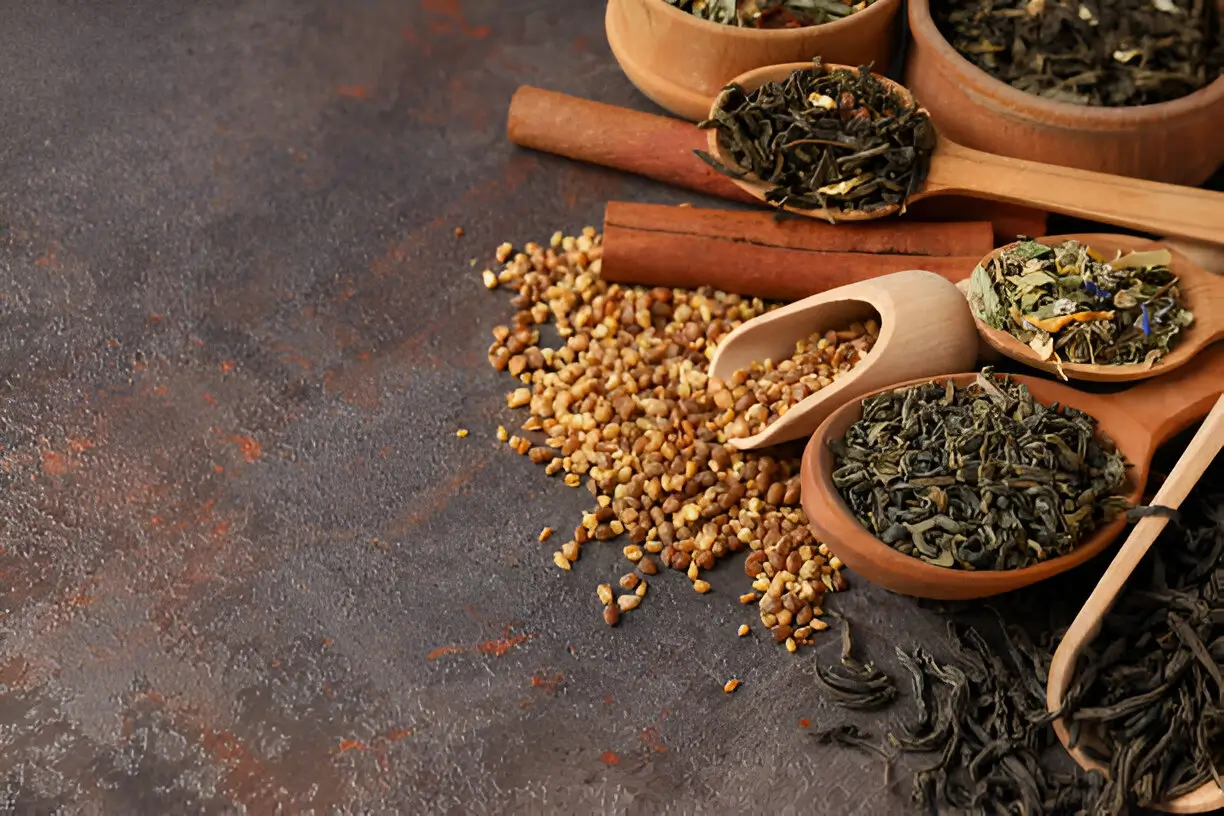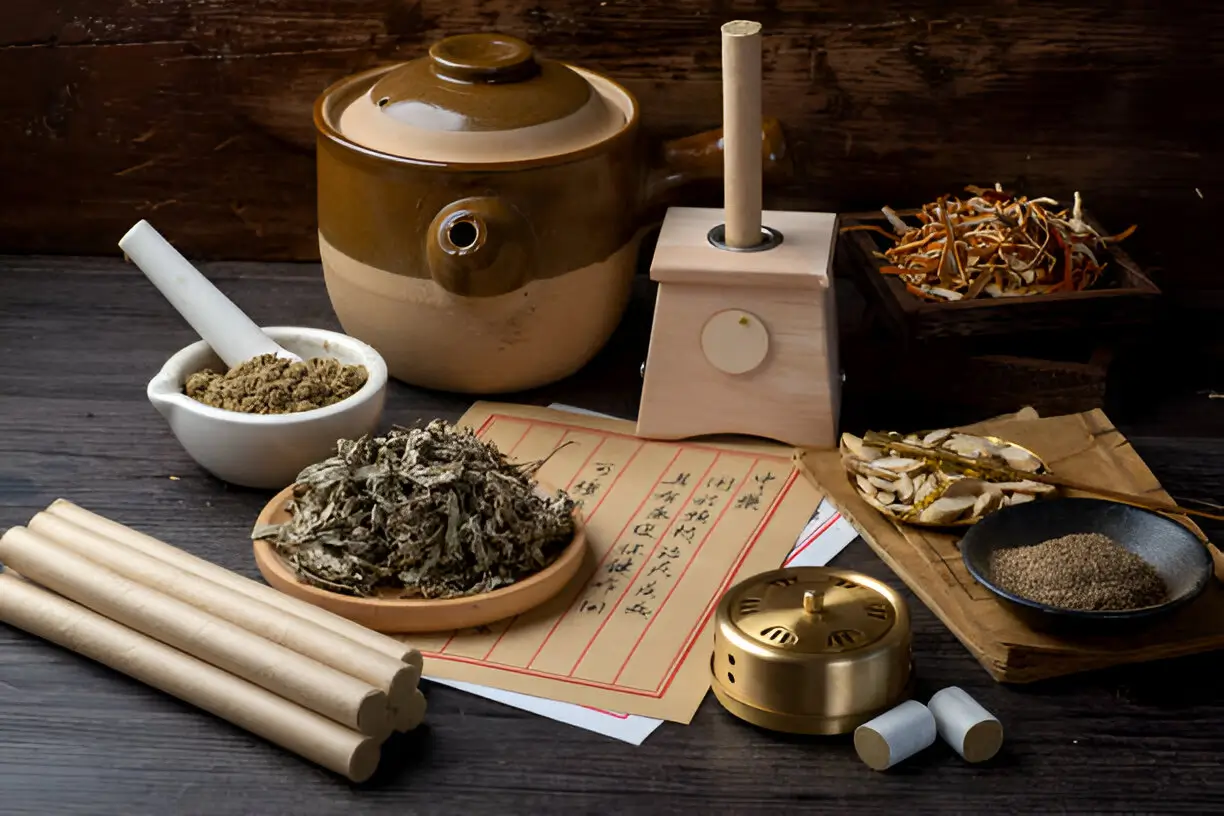Effects of Herbal Medicines on Pain Management
Chinese herbs for pain relief are widely used to manage pain and inflammation naturally. These herbs, such as turmeric, ginger, and ginseng, have anti-inflammatory and analgesic properties that help reduce pain and swelling. Chinese herbs for pain and inflammation, like white willow bark or boswellia, are also effective in managing conditions like arthritis and muscle pain.
These herbs work by inhibiting inflammatory pathways and improving blood circulation, which aids in healing and pain reduction. Adding herbal medicines into pain management is a holistic approach that minimizes the need for synthetic painkillers and reduces their associated side effects.
10 Chinese Herbs for Pain Relief
Next, we’ll describe 10 of the best Chinese herbs for pain relief. It’s important to consult a licensed professional who has the necessary knowledge and expertise in Chinese herbal medicine to create a personalized and effective treatment plan. Picking and using herbs on your own is not advisable, as you may lack sufficient knowledge to do so safely and effectively. These Chinese herbs for inflammation and herbs for pain can offer lots of benefits when used correctly under professional guidance, so that you achieve the best possible results for managing pain and inflammation.
1. Frankincense Resin (Ru Xiang)
Frankincense resin, known as Ru Xiang in Chinese medicine, is derived from the Boswellia tree. It is known for its potent anti-inflammatory and pain-easing properties. Ru Xiang is commonly used to treat conditions such as arthritis, muscle pain, and joint inflammation. It works by improving blood circulation, reducing swelling, and relieving pain.
Frankincense resin can be used in various forms, including powders, capsules, tinctures, and topical applications like oils or balms. In traditional Chinese medicine, it is often added into herbal formulas and taken as a decoction (herbal tea) or in pill form.
2. Turmeric (Jiang Huang)
Turmeric, known as Jiang Huang in Chinese herbal medicine, is a powerful herb known for its anti-inflammatory and pain-relieving properties. It is commonly used to treat conditions such as arthritis, muscle pain, and joint inflammation. Jiang Huang works by reducing inflammation and improving blood circulation.
Turmeric can be used in various forms, including powders, capsules, and tinctures. In traditional Chinese medicine, it is typically included in herbal formulas or prepared as a decoction (herbal tea). For effective and safe use, it is important to consult a licensed practitioner who can provide guidance on the correct dosage and form of turmeric for your specific needs. Using Chinese herbal medicine for pain, like Jiang Huang, is a natural and holistic way to manage discomfort.
3. Safflower Flower (Hong Hua)
Safflower flower, known as Hong Hua in Chinese medicine, is a herb widely used for its pain-relieving and anti-inflammatory properties. It is commonly included in formulations to treat conditions such as menstrual pain, joint pain, and trauma injuries. Hong Hua works by invigorating blood circulation and dispersing blood stasis, which helps ease pain and reduce swelling.
This herb is available in various forms, including dried flowers, powders, capsules, and tinctures. In traditional Chinese medicine, Hong Hua is often prepared as a decoction (herbal tea) or included in herbal formulas. As with all herbs used for pain, it is very important to consult a licensed practitioner to ensure proper dosage and use.
4. Angelica Dahurica
Angelica dahurica, known in Chinese medicine as Bai Zhi, is a versatile herb commonly used for herbal pain relief. It has strong analgesic and anti-inflammatory properties, making it effective for treating headaches, toothaches, and pain related to sinus issues. Bai Zhi is also known for its ability to disperse wind and expel dampness, which helps ease pain and swelling in the body. This herb is typically available in the form of dried root slices, powders, and capsules. In traditional Chinese medicine, it is often brewed as a decoction (herbal tea) or included in complex herbal formulas.
Read Also: What is Chinese Herbal Medicine and What Would You Want to Know About It
5. Sichuan Lovage Root
Sichuan Lovage Root is also known as Chuan Xiong in Chinese herbal medicine. It is particularly effective for treating headaches, muscle pain, and menstrual cramps. Chuan Xiong works by improving blood circulation and dispelling wind, which helps ease pain and reduce swelling.
This herb is available in various forms, including dried root slices, powders, capsules, and tinctures. In traditional Chinese medicine, it is frequently prepared as a decoction (herbal tea) or included in complex herbal formulas. Chuan Xiong is one of the best herbs used for pain in Chinese medicine due to its ability to move Qi and blood, thus easing discomfort.
6. Feverfew (Xiao Bai Ju)
Feverfew is also known as Xiao Bai Ju in Chinese herbal medicine. This Chinese herb for pain is especially effective in treating migraines, headaches, and arthritis. Xiao Bai Ju works by inhibiting (starting) the production of inflammatory substances in the body and reducing muscle spasms. This herb is available in various forms, including dried leaves, capsules, tablets, and tinctures. In traditional Chinese medicine, it is often consumed as tea or included in herbal formulations.
7. Cinnamon (Rou Gui)
Cinnamon is also known as Rou Gui in Chinese herbal medicine, one of the Chinese herbs for menstrual pain relief. It is effective for treating conditions such as arthritis, menstrual pain, and lower back pain. Rou Gui works by invigorating the blood, dispersing cold, and easing pain.
This herb is available in various forms, including sticks, powders, capsules, and tinctures. In traditional Chinese medicine, it is often brewed into tea or included in herbal formulations. Rou Gui is commonly used to boost the effectiveness of other herbs in a formula due to its potent warming properties.
8. Kudzu Root (Ge Gen)
Kudzu Root is also known as Ge Gen in Chinese herbal medicine. It is effective in treating neck and shoulder pain, headaches, and symptoms of hypertension. Ge Gen works by improving blood circulation, relaxing muscles, and relieving tension.
This herb is available in various forms, including dried root slices, powders, capsules, and tinctures. In traditional. Its anti-inflammatory and muscle-relaxing properties make it a popular choice for managing pain and improving overall well-being.
9. Licorice Root (Gan Cao)
Licorice Root is also known as Gan Cao in Chinese herbal medicine. It is commonly utilized to treat conditions including sore throat, cough, digestive issues, and inflammatory conditions. Gan Cao works by harmonizing and improving the effects of other herbs in a formula and reducing inflammation. This herb is available in multiple forms, including dried slices, powders, capsules, and tinctures.
10. Myrrh Resin (Mo Yao)
Myrrh resin is also known as Mo Yao in Chinese herbal medicine, it is a gum resin extracted from the Commiphora myrrha tree. Mo Yao is effective in treating wounds, ulcers, and inflammatory conditions such as arthritis. It works by improving blood circulation, reducing swelling, and easing pain. Myrrh resin can be used in various forms, including powders, capsules, tinctures, and topical applications like ointments and oils.
Marina Doktorman, L.Ac. About Chinese Herbs for Pain Relief
Marina Doktorman, L.Ac., specializes in using Chinese herbal medicine and acupuncture to treat various types of pain at Pulse Acupuncture, located in Williamsburg, Brooklyn, and Clifton, NJ. As a practitioner at our acupuncture clinic, Marina combines traditional Chinese techniques such as cupping and acupuncture for chronic pain with customized herbal remedies.
This ensures effective and holistic pain management for conditions ranging from acute injuries to long-standing chronic issues. With the help of her expertise in Chinese medicine, Marina provides personalized treatments that promote natural healing and long-lasting relief. Visit Pulse Acupuncture to explore the benefits of integrated pain management therapies.
Chinese Herbs for Pain Relief – FAQ
What are Chinese Herbs for Pain Relief?
Chinese herbs for pain relief have been used for centuries in Traditional Chinese Medicine (TCM). These herbs work by addressing the root cause of pain, balancing the body’s energy (Qi), and promoting healing. Many Chinese herbs possess anti-inflammatory, analgesic, and muscle-relaxant properties, which make them effective in relieving pain associated with conditions such as arthritis, back pain, and muscle soreness.
What is the Best Herb for Pain Relief?
There isn’t one “best” herb for pain relief, as it depends on the type and cause of the pain. However, some of the most commonly recommended Chinese herbs for pain relief include Turmeric (Curcuma longa) for its anti-inflammatory properties, Ginger for soothing pain, and Safflower for improving circulation. Angelica Sinensis (Dong Quai) and Corydalis are also known for their pain-relieving benefits, especially for menstrual and muscular pain.
How Do Chinese Herbs for Pain Work?
Chinese herbs for pain relief work by addressing the underlying imbalances in the body. According to TCM, pain often results from blockages in the flow of Qi or blood. Herbs are chosen to restore balance, stimulate blood flow, reduce inflammation, and strengthen the body’s natural healing processes. Some herbs also target specific areas of pain, while others promote overall wellness.
Are Herbal Pain Relief Treatments Effective?
Yes, herbal pain relief can be highly effective, especially for chronic conditions or mild to moderate pain. Many studies have shown that Chinese herbs like Corydalis, Turmeric, and Frankincense can help reduce pain and inflammation, especially when used consistently as part of a holistic treatment plan. However, results may vary depending on the individual, the type of pain, and the specific herbs used.
Can Chinese Herbs Be Used for Chronic Pain?
Yes, Chinese herbs are often used for chronic pain management. Herbs like Corydalis, Angelica Sinensis, and Turmeric have been found to be beneficial for long-term pain relief, especially for conditions such as arthritis, fibromyalgia, and neuropathic pain. However, it’s important to consult a qualified healthcare provider or a TCM practitioner to find the right herbs and dosage for your specific condition.
Are There Any Side Effects of Using Chinese Herbs for Pain Relief?
Chinese herbs are generally considered safe when used under the guidance of a qualified practitioner. However, some herbs can interact with medications or cause allergic reactions. Always consult with a healthcare provider, especially if you have existing health conditions, are pregnant, or are taking other medications. Starting with small doses and monitoring for adverse reactions is also recommended.
-
Marina Doktorman, M.S., L.Ac., is an experienced acupuncturist who obtained her Masters of Acupuncture from the Tri-State College of Acupuncture in New York City in 2001. During her studies, she focused on Chinese Herbology, a branch of Traditional Chinese Medicine (TCM) that utilizes herbs to complement acupuncture treatments. Marina is licensed in both New York (NY) and New Jersey (NJ) and holds a Diplomate of Acupuncture from the National Certification Commission for Acupuncture and Oriental Medicine (NCCAOM), indicating her expertise in the field.







